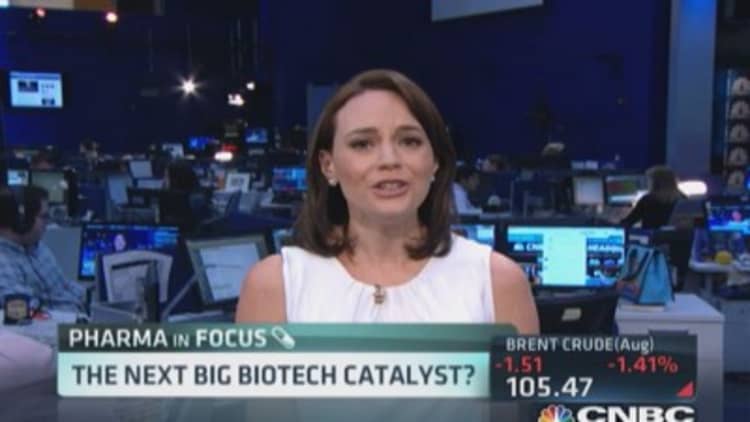
Gilead's hepatitis C medicine Sovaldi drew a record $2.27 billion in revenue in its first quarter on the market, putting it on pace for the fastest drug launch of all time.
Its success isn't just the result of its controversial $84,000 price tag. The market for the drug is huge—an estimated 150 million people worldwide, and 3.2 million in the U.S., have the chronic liver disease.
But there's a new kid on the block in liver disorders, which one analyst suggested may be "the next big global epidemic." It's called NASH, or nonalcoholic steatohepatitis.
Read MoreJ&Jbeats forecasts, helped by new hepatitis C drug
It's got the same characteristics of alcoholic liver disease but arises in folks who don't drink too much alcohol, according to the National Institute of Diabetes and Digestive and Kidney Diseases, which estimates NASH affects 2 percent to 5 percent of Americans. Contributing factors include obesity and diabetes, themselves both on the rise. Like hepatitis C, NASH can be a "silent" disease, initially showing few symptoms, but can lead to cirrhosis, or permanent scarring of the liver.
Read MoreWhy there's no end in sight for higher drug costs
NASH is currently the third most common reason for liver transplants in the U.S., Alethia Young, an analyst with Deutsche Bank, wrote in a research report Monday. She estimates that about 6.5 million adults in the U.S. and the five major European countries have advanced NASH, and puts the peak market for medicines at $35 billion to $40 billion by 2025.
The disease gained the attention of Wall Street in January, when a study of a drug being developed by then little-known biotech company Intercept Pharmaceuticals was stopped early for positive results. Intercept's stock tripled, and though it's tempered since then, the company's market cap is still $4.8 billion. The stock was trading up about 3 percent Monday after Young initiated coverage with a buy rating.
Also working in the space are French biotech Genfit and the hepatitis C heavyweight itself, Gilead, among others.
"It seems these days that everyone is developing a therapy for NASH," Young wrote. "Currently, the NASH space is relatively crowded with early developers. There are no therapies approved yet for use in NASH."
All three companies will have important data reported in the next year, Young said. Further results from Intercept's study have been hailed as one of the major biotech catalysts for the second half—comparable even to the movement seen in Vertex Pharmaceuticals around its data for cystic fibrosis last month.
Read MoreStock soars on stunning results on cystic fibrosis
"There is significant potential upside of 100%+ towards our bull case," Michael Yee, an analyst with RBC Capital Markets, wrote in a research note Sunday. That compares with a downside of 25 percent to 50 percent if the data are weak, he said.
Success may hinge on whether Intercept's drug, obeticholic acid (or OCA), reverses fibrosis, or scarring of the liver, Yee said. There is also concern that it leads to an increase in LDL, or "bad" cholesterol. Yee noted short interest for Intercept has increased by 30 percent to 40 percent since February, meaning investors may be bearish about the results. They results are expected at or before the American Association for the Study of Liver Diseases meeting in November, Young said.
Genfit's drug, GFT-505, is in the same phase of testing, with data expected in the first quarter of 2015. Still much smaller than Intercept, with a market cap of 674.4 million euros, or about $919 million, Genfit also has a potentially major binary event in its future: Young sees upside of about 400 percent on positive study results and downside of about 90 percent if there are safety concerns.
Read MoreTraders' brains have bubble detectors: Researchers
Gilead is expected to have data on its medicine, simtuzumab, next year, Young said. She views its drug as different from Genfit's and Intercept's, which may focus on clearing the disease, while Gilead's drug could be helpful for reversing fibrosis.
Though the medicines are still in the middle stages of testing and are years from the market, the stakes may be high: Yee said Intercept's OCA could draw more than $5 billion in NASH sales. Young goes even higher, estimating potential peak annual sales of up to $12 billion for each of the medicines from Intercept, Genfit and Gilead. That's hepatitis C territory.
—By CNBC's Meg Tirrell

